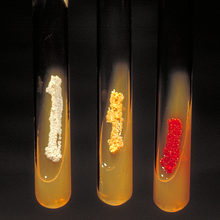Loading AI tools
Genus of bacteria From Wikipedia, the free encyclopedia
Micromonospora is a genus of bacteria of the family Micromonosporaceae. The genus name was first proposed in 1923 by Danish physician Jeppe Ørskov in an attempt to classify what at the time was considered "ray fungi" based on morphology.[1] Members of this genus are found throughout natural soil and sediment environments, as well as in association with roots of plants of various species.[2] The genus is well known for its ability to produce a variety of medically relevant products.
| Micromonospora | |
|---|---|
 | |
| Micromonospora spp. (red colonies) on sloped agar medium, alongside 2 other tubes with differently coloured bacterial colonies. | |
| Scientific classification | |
| Domain: | Bacteria |
| Phylum: | Actinomycetota |
| Class: | Actinomycetia |
| Order: | Micromonosporales |
| Family: | Micromonosporaceae |
| Genus: | Micromonospora Ørskov 1923 (Approved Lists 1980) |
| Type species | |
| Micromonospora chalcea Foulerton 1905; Ørskov 1923 (Approved Lists 1980) | |
| Species | |
|
See text. | |
| Synonyms | |
| |
They are gram-positive, spore-forming, generally aerobic, and form a branched mycelium; they occur as saprotrophic forms in soil and water. Various species are sources of aminoglycoside antibiotics with spellings that end with -micin, such as gentamicin,[3] mutamicin,[4] netilmicin, retymicin, sisomicin,[5][6] verdamicin, calicheamicin, and the recently found turbinmicin.[7] Potent new antifungal drugs discovered in the microbiome of marine animals, unlike most other aminoglycoside names that end with -mycin (e.g. neomycin and streptomycin and are produced by Streptomyces spp.).
Micromonospora comprises the following species:[8]
Seamless Wikipedia browsing. On steroids.
Every time you click a link to Wikipedia, Wiktionary or Wikiquote in your browser's search results, it will show the modern Wikiwand interface.
Wikiwand extension is a five stars, simple, with minimum permission required to keep your browsing private, safe and transparent.